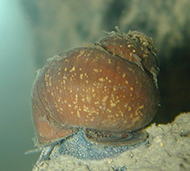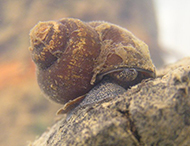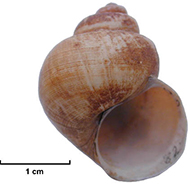
Priorities Action Statement - Actions for the River Snail
Recovery Actions
Advice to consent and determining authorities
- Ensure that councils, government agencies and other relevant organisations are aware of the location of important areas for the River Snail by providing maps and advisory materials of known and/or potential habitat (High priority).
- Negotiate with local councils and industry groups regarding the type and scale of development near key areas either known to support remnant populations of the River Snail or suitable habitat (High priority).
- Provide other relevant information to support appropriate planning and impact assessment (e.g. Environmental Impact Assessment Guidelines) (Medium priority).
Collate and review existing information
- Ensure that all River Snail records are confirmed by an expert and included in the Australian Museum collection (High priority).
- Review regulatory and voluntary incentive based mechanisms available to enhance protection for key habitat areas and apply as required. This may include the use of critical habitat provisions, aquatic reserves, voluntary conservation agreements etc (Medium priority).
- Collate data on the historical distribution of the River Snail (Low priority).
Community and stakeholder liaison, awareness and education
- Actively encourage the reporting and protection of River Snail populations found in artificial environments such as irrigation pipelines (High priority).
- Ensure that the Threatened, Protected and Pest Species Sighting Program is widely promoted throughout the Murray-Darling Basin, and encourage reporting of any sightings of the River Snail in NSW (Low priority).
- Develop and distribute an education kit for use in schools (Low priority).
Enhance, modify or implement NRM planning processes to minimize adverse impacts on threatened species
- Encourage the identification, assessment and modification of natural resource management plans and policies which may impact on River Snail habitats to minimise impacts on stream flow, water quality and riparian vegetation etc (Medium priority).
- Continue to implement the NSW Weirs Policy to remove or reduce/mitigate the impacts of weirs throughout the Murray-Darling Basin (Low priority).
Habitat rehabilitation
- Develop and distribute guidelines regarding flow requirement of the River Snail and distribute this information to relevant natural resource management authorities (Medium priority).
- Advocate appropriate allocation and improved management of environmental flows, particularly in areas known to support, or that could potentially support remnant River Snail populations (Medium priority).
- Provide technical support to community groups, natural resource management authorities, local councils and landholders to protect and rehabilitate riparian vegetation and in-stream habitats along key river stretches where remnant River Snail populations are known or may potentially occur (Medium priority).
- Identify priority barriers to the River Snail based on the location of remnant populations in natural or artificial (pipeline) environments and/or areas identified as potentially suitable, and seek funding for capital works for removal or other remediation works (Medium priority).
Pest eradication and control
- Identify priority areas for targeting of carp eradication and control programs, based on areas where remnant River Snail populations occur or where suitable habitat exists (Medium priority).
Research / monitoring
- Where possible, encourage scientific investigation into key aspects of the biology and ecology of the River Snail. This may include work to establish environmental tolerances, recruitment success, factors influencing population dynamics and variability, age and growth, diet etc (High priority).
- Where possible, ensure that elements of this research are incorporated into funded survey programs. In other cases, actively encourage and support university students to undertake relevant projects (High priority).
- Design and implement a targeted monitoring program for River Snail populations in natural and artificial habitats to enable the effectiveness of recovery actions to be evaluated (Medium priority).
- Review and report on the status and effectiveness of recovery actions in achieving the plans objectives against the performance criteria, and report this information in recovery statements on a three yearly basis (Low priority).
Stocking / translocation
- Investigate the feasibility of establishing a breeding and translocation program in NSW (Medium priority).
- Where possible, actively encourage community involvement in aspects of River Snail recovery including for example, establishment of a breeding and translocation program (Low priority).
Survey / mapping
- Conduct targeted surveys to determine the current distribution of the River Snail in natural and artificial habitats (High priority).
- Continue to collect data on the presence/absence of the River Snail during incidental surveys (High priority).
- Conduct targeted surveys to locate remnant River Snail populations from either natural or artificial habitats (High priority).
*(NB: the PAS actions for River Snail are taken from the approved NSW recovery plan for the species).




